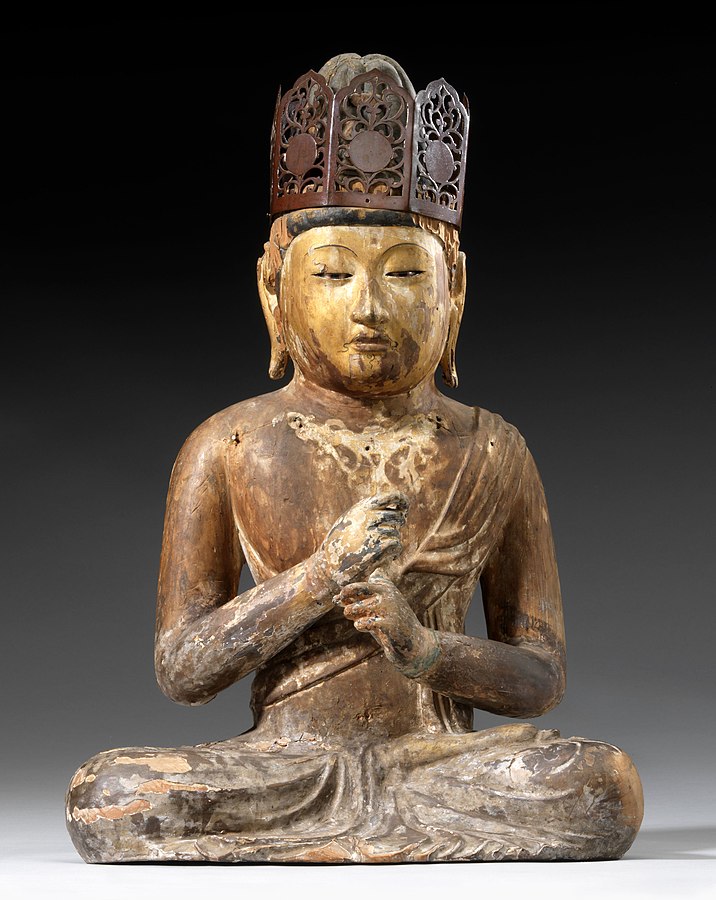“For exoteric Buddhism, the absolute truth, i.e., the Dharma, transcends world and language, and thus cannot be explained. But for esoteric Buddhism, that Dharma itself is being perpetually expressed in and as its embodiment in the phenomenal world, in its sounds, movements, and forms, and even in the thoughts of sentient beings” (John Krummel). This is the “great leap” Huiguo and Kukai achieved when they identified the cosmic Buddha Mahavairocana/Dainichi as the Dharmakaya (Jap hosshin), which allowed Kukai to state “hosshin seppo” – “the Cosmos-as-Buddha expounds the truth.”

Keen to avoid any misunderstanding, Thomas Kasulis writes that “My experience has been that a danger of cultural misrecognition among westerners is to think of Kukai’s Dainichi as a variant of a monotheistic God. So I will say again, Dainichi is not the creator of the universe, nor a personal deity who takes action in this world from a transcendent location behind it. Nor does Dainichi communicate with humans through revelation … Dainichi is the universe.” And this universe is a “set of interdependent actions or processes, not an independently existing agent who does things.” Just as the person also is “set of intrinsically interlinked processes (the skandhas), rather than an independent agent that “performs the thoughts, words, and deeds.”
So, as part of the cosmos, the processes that define the Shingon practitioner“ are a subset of Dainichi’s processes, that is, each of us is a subset of the universe’s function. It follows then that my knowing reality is part of reality’s self-knowing … to understand everything is to partake in everything’s knowing itself. For me to know is to enter “the so-called realm of the buddha’s innermost wisdom.” In Krummel’s words, “the equation of Dainichi’s body-and-mind with the cosmos itself … means the immanent presence of the Buddha within, and as, the body-and-mind of each and every one of us. And so Dainichi’s “enlightened mind” (bodhicitta) becomes synonymous with the Mahayana doctrine of “original enlightenment” (hongaku) within all beings.”

Dainichi is to be thought of as “the behavior of the entire cosmos,” “how” the universe is, rather than “what” the universe is. Dainichi is the self-expression of a cosmos of mutually interpenetrating phenomena (as described in the Huayan/Kegon school). Kasulis writes: “The question then becomes how you can become intimate with Dainichi’s preaching so you can read the universe as Dainichi’s intimations. Kukai’s answer is as follows: Metaphysically speaking, there is only one reality: Dainichi as intimately interlinked activity. Because Dainichi and you are both persons, however, you engage in the same three forms of action, namely, the three intimacies of body, speech, and mind expressed as deed, word and thought. So, as a human being, you can fathom the universe as an intimation of Dainichi’s personal style by deliberately harmonizing your own bodily, verbal, and mental styles with Dainichi’s. The way to understand everything is not to analyze it, but to engage it harmoniously, to be in tune with it … ritual is a form of knowing. As the theory of three intimacies implies, ritual is a three-part harmony among verbal, mental, and bodily action.”
Before getting into the details of Kukai’s “Three Intimacies” (or “Mysteries”), it may be helpful to clarify how far this engagement seeking an attunement with reality is removed from the analytical approach used in Western empiricism. “Empiricism believes an understanding occurs when you detach yourself from the world to observe it, collect data through your external senses, and cull recurrent patterns, often mathematical, out of that array of data. Those patterns are considered the laws of reality … A metaphysics supporting such an empiricist view might envision, for example, a universe of discrete things (elements, substances, atoms) along with forces (energy, God, entropy). Those forces bring the thing into and out of relations with one another to form complexes that you can empirically perceive and logically analyze.”
“Now shift your paradigm of knowing from that of the geologist to that of the potter. In that case, to understand the world is to engage it, to be interdependent and inter-responsive with it, to be part of the universe’s self-unfolding or self-expression. The better you can feel at home in the world or the more you feel part of it instead of separate from it, the better you can understand everything. A metaphysics supporting such a view of understanding might characterize reality as a single, vital system of interrelated processes and resonances, each responding with the others like the notes in a chord instead of bricks in a wall.”
The esoteric practices Kukai taught are based on the “Three Intimacies” (usually referred to as the “Three Mysteries”) of speech, mind, and body (recitation of mantras and dharanis, meditation on mandalas, and mudras).
Sources:
Thomas P. Kasulis – Engaging Japanese Philosophy
John W. M. Krummel – Kukai entry in the Stanford Encyclopedia of Philosophy

